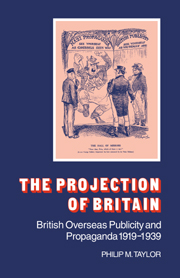Book contents
- Frontmatter
- Contents
- Preface
- Acknowledgements
- Abbreviations
- Introduction
- Part One Publicity and diplomacy, 1919–1939
- 1 The Foreign Office and the press
- 2 The Foreign Office and propaganda abroad
- Part Two The projection of Britain, 1919–1939
- Part Three Psychological rearmament, 1935–1939
- Conclusion
- Notes
- Select bibliography
- Index
1 - The Foreign Office and the press
Published online by Cambridge University Press: 01 October 2009
- Frontmatter
- Contents
- Preface
- Acknowledgements
- Abbreviations
- Introduction
- Part One Publicity and diplomacy, 1919–1939
- 1 The Foreign Office and the press
- 2 The Foreign Office and propaganda abroad
- Part Two The projection of Britain, 1919–1939
- Part Three Psychological rearmament, 1935–1939
- Conclusion
- Notes
- Select bibliography
- Index
Summary
Prior to the outbreak of war in 1914, the Foreign Office possessed no formal apparatus for the regular supply of official information to the press. There did not exist any Whitehall equivalent to the Maison de la Presse at the Quai d'Orsay or the Press Bureau at the Wilhelmstrasse. Unlike many of their continental counterparts, British diplomats generally preferred to conduct their business beneath an umbrella of secrecy, while the Foreign Office may be said to have abstained assiduously from creating any machinery that would serve to encourage a greater level of public participation in what was considered to be the private and exclusive realm of international politics. Publicity and diplomacy were, in other words, considered to be incompatible. It was believed that the conduct of British foreign policy required a high degree of freedom from public scrutiny, whether at home, where – should popular interest manifest itself – it was felt that the majority of people were incapable of appreciating the subtle intricacies of complicated diplomatic manoeuvres, or abroad, where premature disclosures concerning policy aims might produce results prejudicial to British interests and prestige.
Such attitudes, broadly speaking, were firmly entrenched within the foreign-policy-making élite of the nineteenth century. However, they began to come under attack with the gradual trend towards universal suffrage, improving standards of education and literacy (which served to both subsidise and reflect the new developments in journalism towards the close of the century) and the advance of communications technology.
- Type
- Chapter
- Information
- The Projection of BritainBritish Overseas Publicity and Propaganda 1919–1939, pp. 11 - 43Publisher: Cambridge University PressPrint publication year: 1981



